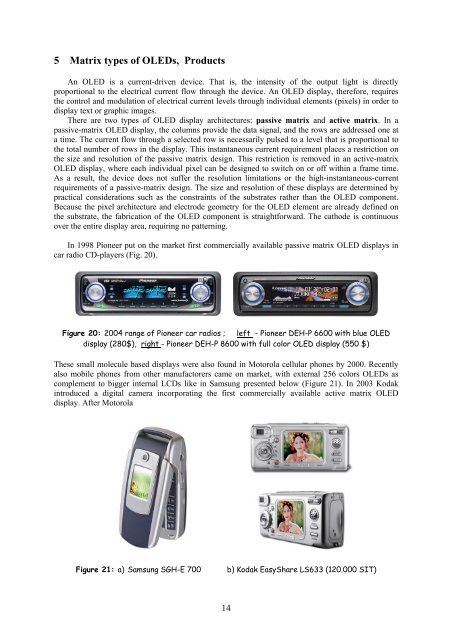You also want an ePaper? Increase the reach of your titles
YUMPU automatically turns print PDFs into web optimized ePapers that Google loves.
5 Matrix types of OLEDs, Products<br />
An OLED is a current-driven device. That is, the intensity of the output light is directly<br />
proportional to the electrical current flow through the device. An OLED display, therefore, requires<br />
the control and modulation of electrical current levels through individual elements (pixels) in order to<br />
display text or graphic images.<br />
There are two types of OLED display architectures: passive matrix and active matrix. In a<br />
passive-matrix OLED display, the columns provide the data signal, and the rows are addressed one at<br />
a time. The current flow through a selected row is necessarily pulsed to a level that is proportional to<br />
the total number of rows in the display. This instantaneous current requirement places a restriction on<br />
the size and resolution of the passive matrix design. This restriction is removed in an active-matrix<br />
OLED display, where each individual pixel can be designed to switch on or off within a frame time.<br />
As a result, the device does not suffer the resolution limitations or the high-instantaneous-current<br />
requirements of a passive-matrix design. The size and resolution of these displays are determined by<br />
practical considerations such as the constraints of the substrates rather than the OLED component.<br />
Because the pixel architecture and electrode geometry for the OLED element are already defined on<br />
the substrate, the fabrication of the OLED component is straightforward. The cathode is continuous<br />
over the entire display area, requiring no patterning.<br />
In 1998 Pioneer put on the market first commercially available passive matrix OLED displays in<br />
car radio CD-players (Fig. 20).<br />
Figure 20: 2004 range of Pioneer car radios ; left - Pioneer DEH-P 6600 with blue OLED<br />
display (280$), right - Pioneer DEH-P 8600 with full color OLED display (550 $)<br />
These small molecule based displays were also found in Motorola cellular phones by 2000. Recently<br />
also mobile phones from other manufactorers came on market, with external 256 colors OLEDs as<br />
complement to bigger internal LCDs like in Samsung presented below (Figure 21). In 2003 Kodak<br />
introduced a digital camera incorporating the first commercially available active matrix OLED<br />
display. After Motorola<br />
Figure 21: a) Samsung SGH-E 700 b) Kodak EasyShare LS633 (120.000 SIT)<br />
14

















